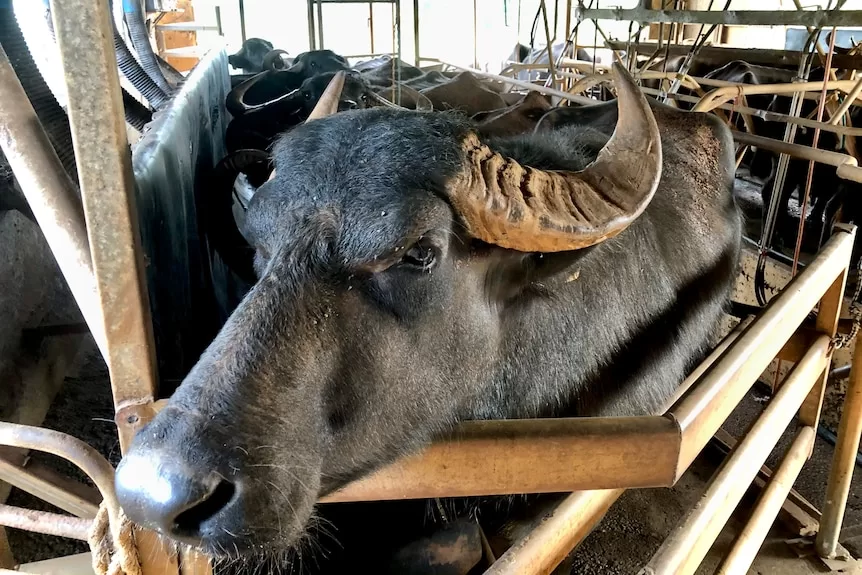An 85-year-old inspiration, Margaret Thompson heads into Maleny Buffalo’s dairy every day to keep her late husband Mal’s legacy alive.
The petite, deep-thinking, determined farmer is dwarfed by the large, gentle, horned cows she milks, admitting it was Mal’s idea to swap cattle for buffalo when Australia’s dairy industry was deregulated.
“I wanted to just run steers but he wanted buffalo, so we had them and it’s like keeping part of him alive, I guess it is the driving force,” Ms Thompson said.
“We now milk once a day and the calves come out to be with them after milking, and we lock the calves up again in the afternoon and milk the cows in the morning.”
Buffalo milk, cheese and meat
These days Ms Thompson’s son Michael milks by her side and has expanded the meat side of their business, working to reach Australians who have never tasted buffalo milk, cheese, or meat.
Their aim to raise awareness has had help from one of the Sunshine Coast’s best restaurants.
Geoff Abel, head chef at The Long Apron at Spicers Clovelly Estate, drives past Maleny Buffalo’s 140-strong herd in Witta on his way to work in Montville.
He curated a creative long lunch, serving up 10 delicious plates to showcase buffalo’s versatility to dozens of guests, including the farmers who produced it.
From a deconstructed cheesecake with Davidson plum sorbet and meringue shards to a rib fillet cooked over coals, and sourdough made with Maleny Buffalo whey, Abel said it was the first time he’d designed every dish in a long lunch around one farm.
“We were able to get an entire menu from snacks, to entrees, to mains to desserts and every single item on the menu was featuring buffalo whether it was a meat product or a dairy product,” Abel said.
“I really believe that when you eat somewhere you should know where you are in the world, so that’s what we’re trying to do here.”
Deconstructed buffalo cheesecake with Davidson plum sorbet and meringue shards. Supplied: Creative Tours
Maleny Buffalo whey sourdough with buffalo cultured butter. Supplied: Creative Tours
Buffalo salami with fresh greens and sliced radish. Supplied: Creative Tours
Buffalo rib fillet cooked over coals. Supplied: Creative Tours
Cheese and sweet treats
Maleny Buffalo’s milk is sent to Byron Bay Mozzarella, Maleny Cheese and Olympus cheese in Brisbane and is increasingly sold to Australia’s Indian communities for use in making sweet treats.
“It’s a bit hard keeping it up to them all, but they can only get as much as we can give them,” Ms Thompson said.
Michael Thompson said there was growing awareness of the health values of buffalo milk.
According to the Australian Buffalo Industry Council it has up to 58 per cent more calcium, 40 per cent more protein, and 43 per cent less cholesterol than cow’s milk .
“Five or six years ago it was so hard to open doors, but now the doors are being opened for us,” Mr Thompson said.
“It’s very humbling to have people that want to enjoy our product and come to us.”
History of the buffalo
Awarded a Churchill Fellowship, Ms Thompson travelled overseas to expand her knowledge of buffalo farming.
Water buffalo were domesticated thousands of years ago and their geographical origin has been tracked back to central India.
The highly social animals have been used for their meat and milk, for transport, and to plough fields.
Introduced to Australia in the 1820s, buffalo are tick-resistant and now farmed in every state and territory.
According to Northern Territory government data, their meat is leaner than chicken, pork, beef or fish, with a cholesterol content about 75 per cent that of beef farmed similarly.
They have fewer sweat glands and can overheat, wallowing in water to cool down.
Milk prized by Iraqi community
Based at Kerang in Victoria, Buffalo Milk Australia is another of the few dairies in the country.
Owner Mitch Humphries said Australia’s Iraqi community prized water-buffalo milk, making a thickened cream called geymar or kaymak.
“The demand for milk has been steadily increasing; there’s never been a big gap between demand and supply,” Mr Humphries said.
Rather than being competitive, Ms Thompson said farmers worked together to raise the profile of the industry.
“It’s very collaborative and that’s what’s made it so successful, we’re enthusiastic.”
